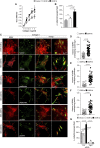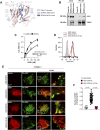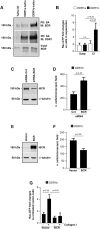The Collagen Receptor Discoidin Domain Receptor 1b Enhances Integrin β1-Mediated Cell Migration by Interacting With Talin and Promoting Rac1 Activation
- PMID: 35309920
- PMCID: PMC8928223
- DOI: 10.3389/fcell.2022.836797
The Collagen Receptor Discoidin Domain Receptor 1b Enhances Integrin β1-Mediated Cell Migration by Interacting With Talin and Promoting Rac1 Activation
Abstract
Integrins and discoidin domain receptors (DDRs) 1 and 2 promote cell adhesion and migration on both fibrillar and non fibrillar collagens. Collagen I contains DDR and integrin selective binding motifs; however, the relative contribution of these two receptors in regulating cell migration is unclear. DDR1 has five isoforms (DDR1a-e), with most cells expressing the DDR1a and DDR1b isoforms. We show that human embryonic kidney 293 cells expressing DDR1b migrate more than DDR1a expressing cells on DDR selective substrata as well as on collagen I in vitro. In addition, DDR1b expressing cells show increased lung colonization after tail vein injection in nude mice. DDR1a and DDR1b differ from each other by an extra 37 amino acids in the DDR1b cytoplasmic domain. Interestingly, these 37 amino acids contain an NPxY motif which is a central control module within the cytoplasmic domain of β integrins and acts by binding scaffold proteins, including talin. Using purified recombinant DDR1 cytoplasmic tail proteins, we show that DDR1b directly binds talin with higher affinity than DDR1a. In cells, DDR1b, but not DDR1a, colocalizes with talin and integrin β1 to focal adhesions and enhances integrin β1-mediated cell migration. Moreover, we show that DDR1b promotes cell migration by enhancing Rac1 activation. Mechanistically DDR1b interacts with the GTPase-activating protein (GAP) Breakpoint cluster region protein (BCR) thus reducing its GAP activity and enhancing Rac activation. Our study identifies DDR1b as a major driver of cell migration and talin and BCR as key players in the interplay between integrins and DDR1b in regulating cell migration.
Keywords: Rac1; extracellular matrix; integrins; migration; receptor activation; receptor tyrosine kinase.
Copyright © 2022 Borza, Bolas, Zhang, Browning Monroe, Zhang, Meiler, Skwark, Harris, Lapierre, Goldenring, Hook, Rivera, Brown, Leitinger, Tyska, Moser, Böttcher, Zent and Pozzi.
Conflict of interest statement
The authors declare that the research was conducted in the absence of any commercial or financial relationships that could be construed as a potential conflict of interest.
Figures






Similar articles
-
Overexpression of discoidin domain receptor 1 increases the migration and invasion of hepatocellular carcinoma cells in association with matrix metalloproteinase.Oncol Rep. 2007 Dec;18(6):1435-41. Oncol Rep. 2007. PMID: 17982627
-
Function of discoidin domain receptor I in HGF-induced branching tubulogenesis of MDCK cells in collagen gel.J Cell Physiol. 2005 Apr;203(1):295-304. doi: 10.1002/jcp.20227. J Cell Physiol. 2005. PMID: 15468059
-
Discoidin domain receptor-1a (DDR1a) promotes glioma cell invasion and adhesion in association with matrix metalloproteinase-2.J Neurooncol. 2006 Feb;76(3):239-48. doi: 10.1007/s11060-005-6874-1. J Neurooncol. 2006. PMID: 16234985
-
Recent Advances in the Role of Discoidin Domain Receptor Tyrosine Kinase 1 and Discoidin Domain Receptor Tyrosine Kinase 2 in Breast and Ovarian Cancer.Front Cell Dev Biol. 2021 Nov 3;9:747314. doi: 10.3389/fcell.2021.747314. eCollection 2021. Front Cell Dev Biol. 2021. PMID: 34805157 Free PMC article. Review.
-
Discoidin domain receptors: Micro insights into macro assemblies.Biochim Biophys Acta Mol Cell Res. 2019 Nov;1866(11):118496. doi: 10.1016/j.bbamcr.2019.06.010. Epub 2019 Jun 21. Biochim Biophys Acta Mol Cell Res. 2019. PMID: 31229648 Free PMC article. Review.
Cited by
-
Reciprocal discoidin domain receptor signaling strengthens integrin adhesion to connect adjacent tissues.bioRxiv [Preprint]. 2023 May 16:2023.03.14.532639. doi: 10.1101/2023.03.14.532639. bioRxiv. 2023. Update in: Elife. 2023 Jul 05;12:RP87037. doi: 10.7554/eLife.87037. PMID: 36993349 Free PMC article. Updated. Preprint.
-
Discoidin domain receptor 2 is an important modulator of BMP signaling during heterotopic bone formation.Bone Res. 2025 Jan 2;13(1):7. doi: 10.1038/s41413-024-00391-z. Bone Res. 2025. PMID: 39746922 Free PMC article.
-
Reciprocal discoidin domain receptor signaling strengthens integrin adhesion to connect adjacent tissues.Elife. 2023 Jul 5;12:RP87037. doi: 10.7554/eLife.87037. Elife. 2023. PMID: 37405383 Free PMC article.
-
The guanine nucleotide exchange factor Vav3 intervenes in the migration pathway of oligodendrocyte precursor cells on tenascin-C.Front Cell Dev Biol. 2022 Nov 30;10:1042403. doi: 10.3389/fcell.2022.1042403. eCollection 2022. Front Cell Dev Biol. 2022. PMID: 36531963 Free PMC article.
-
Blockade of DDR1/PYK2/ERK signaling suggesting SH2 superbinder as a novel autophagy inhibitor for pancreatic cancer.Cell Death Dis. 2023 Dec 9;14(12):811. doi: 10.1038/s41419-023-06344-4. Cell Death Dis. 2023. PMID: 38071340 Free PMC article.
References
-
- Alves F., Vogel W., Mossie K., Millauer B., Höfler H., Ullrich A. (1995). Distinct Structural Characteristics of Discoidin I Subfamily Receptor Tyrosine Kinases and Complementary Expression in Human Cancer. Oncogene 10, 609–618. - PubMed
Grants and funding
LinkOut - more resources
Full Text Sources
Research Materials
Miscellaneous

